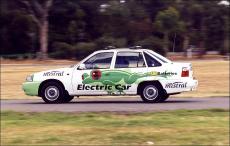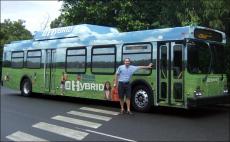Forget century-old braking…
One of the aspects I like most about hybrid and electric-powered vehicles is regenerative braking.
Regeneration braking (“regen”) occurs when the electric motor is used as a generator, so charging the battery and in turn slowing the vehicle.
Regen is important for energy-efficiency – the energy that would normally be wasted in friction braking is instead utilised. In many driving conditions this can result in a substantial improvement in fuel economy (hybrids) or driving range (battery electric).
However, I like regen most because it is really effective from a driving perspective.
Unlike friction braking, the faster that you are going, the better regen works. The faster-moving vehicle has more potential energy that in turn can be turned into more electric energy. That’s the case with friction braking as well (the potential energy is higher so more heat energy can be generated) but since conventional brakes reduce in effectiveness as they are required to do more work, the feeling is not the same.
Regen braking can feel like the ‘inexorable giant hand’ pulling you back, all with smoothness and a degree of control that is impossible to obtain with friction brakes.
And let’s look at the subject of control for a moment.
Traditional cars use separate pedals for the accelerator and the brake only because of the origins of the technology. The ‘brakes’ and the ‘engine’ have always been effectively two separate systems. Even today, in most cars the only link between the engine and the brakes is the vacuum brake booster line.
Having separate pedals for ‘go’ and ‘stop’ seems to me to be absurd. If the parameter is ‘acceleration’, and that parameter needs to be varied on a continuum from maximum negative to maximum positive acceleration, why shouldn’t one driver input do it?
Some electric cars almost achieve this by controlling both electric motor power and regen braking with the one pedal. At (say) the half-way point in the pedal travel, the car is neither braking nor accelerating. At full accelerator pedal travel, it is accelerating as hard as it can. At full lift-off, it is (regen) braking as hard as it can. In these cars, the friction brakes are used just for the last few metres of a normal stop, and also for emergency braking.
(If you’re prepared to trade-off some energy efficiency, the electric motor braking can bring you to a complete halt – and probably also do emergency braking. You just drive the electric motor backwards – or try to drive it backwards, anyway!)

An electric car I drove some time ago used the one pedal for both regen braking and acceleration. At that time I wrote a commentary saying how good the combined brake/accelerator pedal approach was, only to have people suggest that the braking side would feel awful – like a traditional car that needed to have its brakes bled!
But I think that comment was simply because the people were stuck in a paradigm of conventional car control.
Think instead of sailing a boat. Long ago I used to have a small catamaran. Flying one hull (something at which I was rather inexpert) was for me the greatest buzz. With one hull up in the air, too much propulsion from the sail would overturn the boat; too little would settle the flying hull back into the water.
The amount of power being generated by the sail was controlled by the mainsheet – the rope that controlled the angle of the boom to the wind. Let the mainsheet right out and the boat would brake strongly, the hulls sinking into the water. Pull the mainsheet in and the boat would accelerate.
Both braking and acceleration were controlled by the one rope, a system that allowed you to play wonderful nuances with the angle of boat heel. The idea that you might need to grab another rope to slow the boat is absurd, and certainly for this novice sailor it would have made everything very hard indeed.
However, major hybrid and electric car manufacturers have steered clear of using a combined accelerator/regen braking pedal. Instead, they typically apply a little regen when the throttle is fully lifted, and then apply more regen as the brake pedal is pressed. Some hybrid vehicles (like the Prius) monitor hydraulic braking pressure and alter regen in sympathy with friction brake use, while others (like the Honda Insight) apply regen in the first portion of brake pedal travel and then allow hydraulic braking to take over.
And it’s my hybrid Honda Insight that made me think about this topic.
I’ve modified the throttle control of the car so that a number of non-standard things happen. One new outcome is that rather than the car regen braking as soon as the throttle is quickly lifted, there is a pause of a few seconds before the regen then smoothly comes in.
This works extremely effective in practice. Think about it for a moment. Quite often in normal driving you might take your foot off the throttle – eg when going downhill and not wanting to exceed a speed limit, or maintaining a gap to a car in front that is slowing. However, equally often that throttle-lift will be only momentary. But if you have your foot off the throttle for more than few seconds, it’s usually because you really want to slow down.
So regen that takes a few seconds of throttle-lift to come into effect works rather well. You can roll the car by lifting the throttle, or brake the car by simply keeping your foot lifted for longer.
Such braking behaviour is of course impossible with a normal friction braked car.
 And you can take it further. What about mapping throttle-lift regen braking against vehicle speed (and so actual potential energy)? Or having switchable sporty mode regen braking that is much stronger than normal? (The pictured GM Hybrid bus I drove could be configured to have regen braking strong enough to lock the wheels!)
And you can take it further. What about mapping throttle-lift regen braking against vehicle speed (and so actual potential energy)? Or having switchable sporty mode regen braking that is much stronger than normal? (The pictured GM Hybrid bus I drove could be configured to have regen braking strong enough to lock the wheels!)
It’s not something that many ‘green’ vehicle enthusiasts seem to stress, but regen brakes that work seamlessly and strongly with infinite control, and can have their behaviour mapped against other car parameters, make traditional hydraulic brakes look like the 100 year old technology they really are.
I think that regen braking has the potential to make a whole new generation of driving enthusiasts…

 Julian Edgar, 50, has been writing about car modification and automotive technology for nearly 25 years. He has owned cars with two, three, four, five, six and eight cylinders; single turbo, twin turbo, supercharged, diesel and hybrid electric drivelines. He lists his transport interests as turbocharging, aerodynamics, suspension design and human-powered vehicles.
Julian Edgar, 50, has been writing about car modification and automotive technology for nearly 25 years. He has owned cars with two, three, four, five, six and eight cylinders; single turbo, twin turbo, supercharged, diesel and hybrid electric drivelines. He lists his transport interests as turbocharging, aerodynamics, suspension design and human-powered vehicles.

on April 10th, 2008 at 11:24 pm
I agree, you can have so much more control when you can keep your foot in one place. I noticed the new Vetrix electric maxi-scooter (released in melbourne) does the same thing… pull back on the throttle like a normal bike to go but twist the other way for regen. I am curious about how you could possibly lock up the wheels with regen? As soon as the wheel stopped moving you would lose all the force in the motor (dependant on speed) that was causing it to lock up… I always thought regen had natural ABS like that. So how could the wheels lock?
on April 11th, 2008 at 7:23 am
Yes, good point re regen and wheel locking. I don’t know the answer: the engineers in charge of the hybrid GM bus told me it could lock its wheels if configured to do so and I didn’t challenge that. Perhaps I should have!
on April 11th, 2008 at 9:06 am
The single-control aspect of what you’re talking about doesn’t require regen, just brakes that take their energy from somewhere other than the driver, like the Citroen high-pressure system (half-century-old braking; and if you really think friction brakes get less effective as you lean on them, you haven’t had the pleasure of stomping on the brake pedal of a DS at speed).
Haven’t various manufacturers experimented with joystick systems that do that? As well as removing the biggest injury hazards in an accident from out in front of the driver’s face and legs… I know that was Volvo’s stated motivation. Who knows what GM were thinking, other than “how can we make this car REALLY strange”.
on April 19th, 2008 at 12:50 am
Good points, but four-wheel hydraulic brakes are not quite a 100 year-old technology. If memory serves, hydraulic brakes were introduced at the 1921 French Grand Prix by Duesenburg. Prior systems were wholly mechanical. Of course the mechanical basics of friction braking date back much farther than 100 years.
Now if we could just get regen braking on a proper electrically-assisted turbo (or “twincharged”) V8 . . . .
on July 2nd, 2008 at 1:08 am
I just read the article on modifying regen braking on a prius, and came across the problem of the brakes not being smooth when you first apply them (with the voltage offset being applied fully when the brake switch was triggered) and had a thought.
Could the digital fuel adjuster be used to overcome this? As well as allowing you to get rid of the jump, you could program in whatever characteristics you wanted (to a degree).
Regen braking article:
http://autospeed.com/cms/A_2392/article.html
on November 29th, 2008 at 1:33 am
Hello Julian.
Found your aspects on 100 year old pedal arrangements! Myself invented a new combined acc-brake pedal 1997 and got approval for installing this device all over Europe starting by the Swedish Road Administration. Some 8 different carmanufacturers have tried this system which can reduce the reaction time by half and most important, avoid missapplications! Yours Sven Gustafsson Entrepreneur